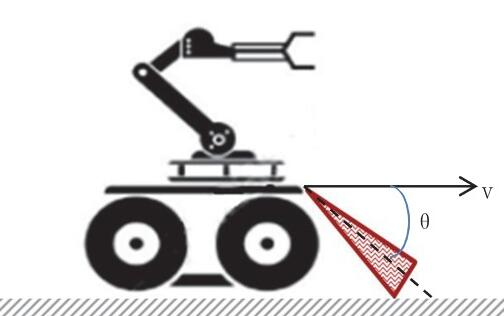What are the applications of millimeter wave radar sensors in robots?
Millimeter wave sensor detects glass wall
In modern buildings, glass walls and partition walls are common applications, and service robots (such as vacuum cleaners or mopping robots) need to perceive these surfaces to prevent collisions. It turns out that it is difficult to detect these elements using cameras and infrared sensors. But millimeter wave sensors can detect the presence of glass walls and objects behind them.
Millimeter wave sensor measures ground velocity
Accurate odometer information is essential for autonomous movement of the robot platform.
We can obtain this information by measuring the rotation of wheels or belts on the robot platform. However, if the wheels are slipping on loose gravel, mud or wet ground, this low-cost method will obviously not work easily.
We can use millimeter wave sensors to measure ground velocity. Millimeter wave sensors can send chirp signals to the ground and measure the Doppler frequency shift of the returned signals, providing additional odometer information for robots that traverse uneven terrain or have more chassis pitch and yaw conditions.
The following figure shows the potential configuration of the ground speed millimeter-wave radar sensor on the robot platform-there is a trade-off between whether to point the radar in front of the platform (as shown in the figure) or behind the platform (standard practice for agricultural vehicles). If you point to the front of the platform, you can also use the same millimeter wave sensor to detect the edge of the surface to avoid unrecoverable platform losses, such as falling from the warehouse loading platform. If it is pointed behind the platform, the sensor can be installed on the center of gravity of the platform to minimize the influence of pitch and yaw on the measurement, which is a big problem in agricultural applications.

Ground speed radar configuration on the robot platform
In addition, more advanced systems can ensure that the odometer is very accurate by adding an IMU (sometimes enhanced by GPS).
As robots interact more with humans in service capabilities or in flexible low-batch processing automation tasks, it must be ensured that they do not cause harm to the people with whom they interact. In the past, a common method was to create a safety barrier or exclusion area around the robot's work area to ensure physical isolation.
The sensors enable virtual safety curtains or bubbles to separate robot operations from unplanned human interactions, while avoiding collisions between robots and robots due to increased density and operational programmability. Vision-based security systems require controlled lighting, which increases energy consumption, generates heat, and requires maintenance. In a dusty manufacturing environment (such as textiles or carpet weaving), frequent cleaning and attention to lenses are required. Millimeter wave sensors can be applied to this.
Because millimeter wave sensors are very powerful, they can detect objects regardless of the lighting, humidity, smoke, and dust in the workshop, so they are very suitable to replace the vision system, and can provide this with extremely low processing delay (usually less than 2ms) Detection. Because these sensors have a wide field of view and a long detection range, installing them above the work area can simplify the installation process. Only one millimeter wave sensor can detect multiple objects or people, reducing the number of sensors required and reducing costs.
Mapping and navigation using millimeter wave sensors
millimeter wave radar sensor can accurately map the obstacles in the room and operate autonomously in the marked free space. First, it efficiently navigates to the selected location, then rotates to the appropriate posture, avoids static and dynamic obstacles in its route, and finally reaches the destination.
This article is from Allicdata Electronics Limited which offer electronic components, semiconductors, antennas, capacitors, connectors, diodes, transistors, IC,resistors. For more product information, please go to the website to get it.

